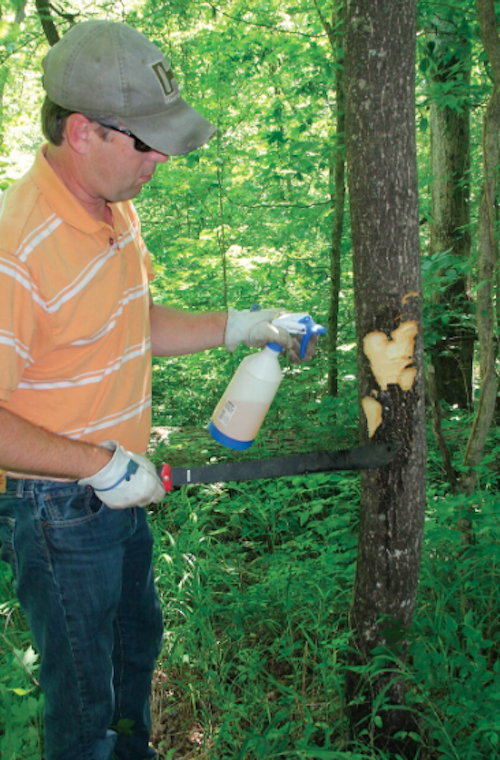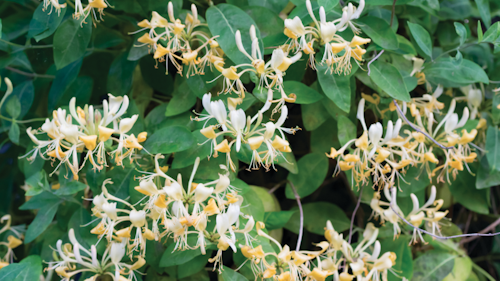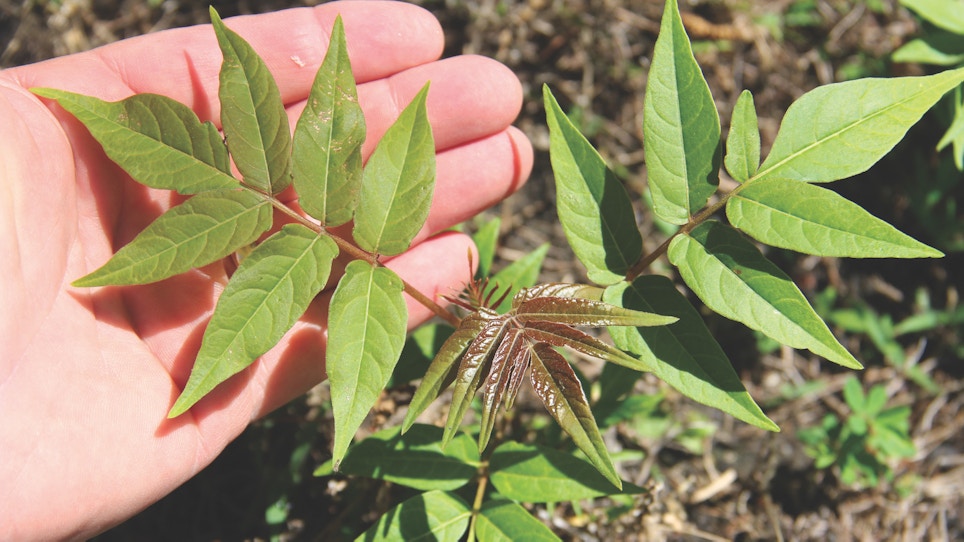A young tree-of-heaven is a non-native tree that often overtakes native plant communities. Most invasive plants provide no benefit to wildlife. Photo: David Hart
In the south, kudzu swallows up entire forests with a wall of cascading vines. Midwestern fields are blanketed with towering stands of Johnsongrass where native forbs and grasses once grew. Impenetrable stands of Phragmites, also known as common reed, choke out native vegetation in wetlands in nearly every state. Everywhere you look these days, a non-native, invasive plant is taking over the landscape — including your favorite place to hunt deer.
They don’t just overwhelm native plant communities. Those invasive plants rob your property of valuable space. Plants like cogongrass, sericea lespedeza, kudzu and Johnsongrass choke out nearly every other plant. They form massive, dense monocultures that offer little, if any, benefit to deer and other wildlife.
In nearly every case, invasive plants are nothing but trouble.
“Deer don’t eat many of them, either,” says Matt Ross, Quality Deer Management Association assistant conservation director. “Even the non-native, invasive plants they do eat aren’t always the best choices.”
Non-Native, But Not Invasive
That’s not to say some non-native plants aren’t beneficial. Many of the food plot plants we grow are not native to the United States. The difference, says Ross, is that many non-native plants like soybeans and even various members of the brassica family are not invasive. They won’t grow without some help and they rarely, if ever, spread and overtake entire ecosystems. Invasive plants, on the other hand, spread continually until there is little else growing.
“The cost of invasive plants is staggering,” says Center for Invasive Species Mapping Coordinator Rebekah Wallace. “Those costs include everything from control efforts to the loss of productivity due to invasive plants. We are doing everything we can to fight them, but it is a difficult battle.”
Efforts to control some invasive plants have been met with limited success, but it is unlikely any of the most widespread and aggressive plants will ever be eradicated. That doesn’t mean you shouldn’t do anything about invasive species on a local scale, Wallace says. With some effort, time and money, it is possible to clear your fields and forest edges of even the most aggressive invasive plants.
“It can really help if you form some sort of cooperative with your neighbors," says Wallace. "You might be able to reduce or even eliminate some invasive plants on your land. But if they still grow on your neighbors, it will be a constant battle. Birds and wind will carry the seeds onto your property.”

Cooperative or not, knocking back invasive plants will benefit your deer and the rest of the wildlife on your land. This is true, even if your neighbors don’t bother. In fact, the effort you make that your neighbor fails to make could mean better hunting on your land, thanks to an increase in more native food sources and better habitat overall.
“I would first try to learn the worst four or five invasive species in your region and focus on them,” Ross says. “There might be dozens of non-native plants on your land, but most likely just a few of them are the most problematic.”
The good news is that identification aids are readily available on your computer or even your smartphone. One of the best and most thorough websites is invasive.org. It not only lists and describes nearly 2,000 species of invasive plants found in the US, it has historical backgrounds, countries of origin and a range of plant photos. Several other websites exist to help landowners identify plants. Many of them are state or region-specific. Some smartphone apps will even identify a plant immediately after you take a photo of it.
Control Them
Once you know what you are dealing with, you can take steps to reduce or completely rid your land of those troublesome plants. The simplest and fastest method is with chemicals. Non-selective herbicides will kill virtually every plant they come in contact with. In most cases, they are the only tool. Mowing and even burning tends to stimulate rapid spreading and growth. Additionally, it doesn’t eliminate the root systems of perennial invasive plants.
Glyphosate, the active ingredient in Roundup, is a good all-purpose herbicide and is relatively inexpensive. Although a few plants are resistant to it, most aren’t. A thorough soaking based on the label’s recommended application rate will kill the plants you want gone. For trees and larger shrubs, hack a few notches into the bark with a machete and squirt undiluted glyphosate into the cuts. That’s usually all it takes to kill tree-of-heaven, Chinese privet and autumn olive, among others.
“Don’t worry if you overspray around the target plant and kill non-target plants," Ross says. "There is almost always a good native seed bank in the soil that is waiting for the right conditions to sprout and grow. It’s not unusual to see new plants growing within a few weeks or even days after you spray.
Be vigilant. Some of those new plants might be the seedlings of the same non-native, invasive plants you just killed. Their seeds can remain dormant for years, even decades, and will continue to sprout until gone. Once you've sprayed, avoid disturbing the soil. Soil disturbance can stimulate new growth of invasive species.
One solution for the most problematic invasive plants is to turn the area into a long-term food plot with a Roundup-ready crop like soybeans. Plots of other annuals like brassicas or crimson clover allow you to spray undesirable plants too. A repeated cycle of disking and spraying will deplete the weed seed bank after a few years.
Baby Steps
If it seems like a lot of work, you’re right. Knocking back a field choked with lespedeza or a forest edge covered in kudzu can feel pointless. Why bother when those unwanted plants cover so much ground already?
“They tend to get worse if you don’t try to get them under control. The longer you wait, the worse they might get,” Ross says.
He suggests taking small bites as a way to make the job a little easier.
“Focus on small areas or a specific invasive and get it under control before moving to a new area," Ross says. "It can seem overwhelming if you have a large property and a lot of area covered with invasive plants but, if you break it into smaller sections, you can see progress."
Consider dedicating an hour or two a few evenings a week to invasive control. Simply fill up a sprayer and walk your land, spraying those plants you want to eradicate as you go. It can take an entire season or even a couple of years to get them under control, but your deer, turkeys and quail will be thankful for your efforts.
Bonus: Not So Bad?

Some non-native, invasive plants are consumed by whitetail deer. Japanese honeysuckle, a vine with fragrant flowers that grows along field edges throughout the U.S., is high in protein and readily digestible. Deer love it, especially in the winter. They also eat autumn olive, an aggressive, non-native shrub originally planted for wildlife.
“That doesn’t mean it is a better choice than native plants,” says Ross. “I would at least recommend managing things like honeysuckle so it doesn’t overwhelm your landscape. Diversity is a key ingredient in quality deer habitat. Allowing an invasive plant to take over will result in a monoculture of that plant. Keep them controlled so they don’t overwhelm your property.”






